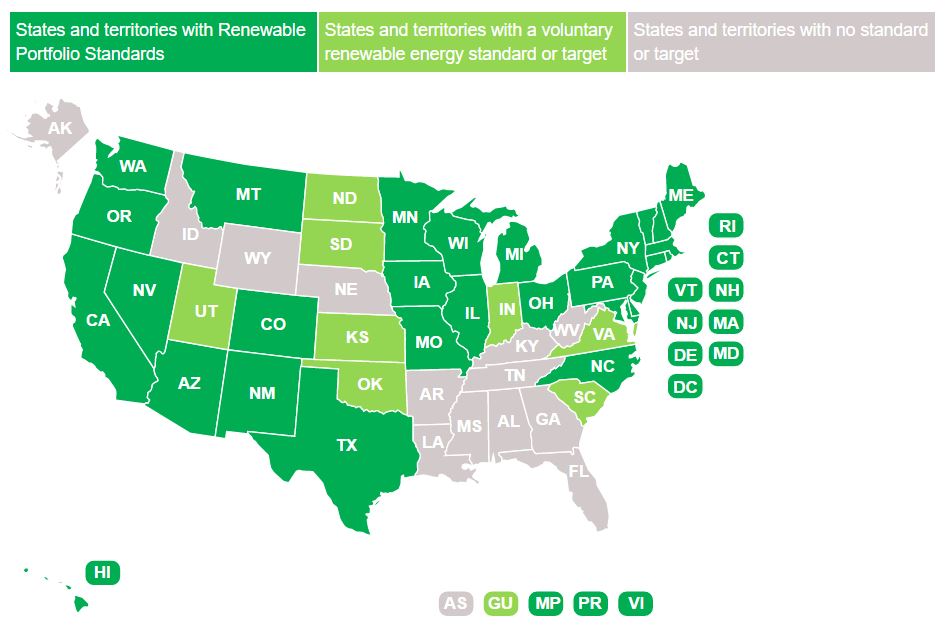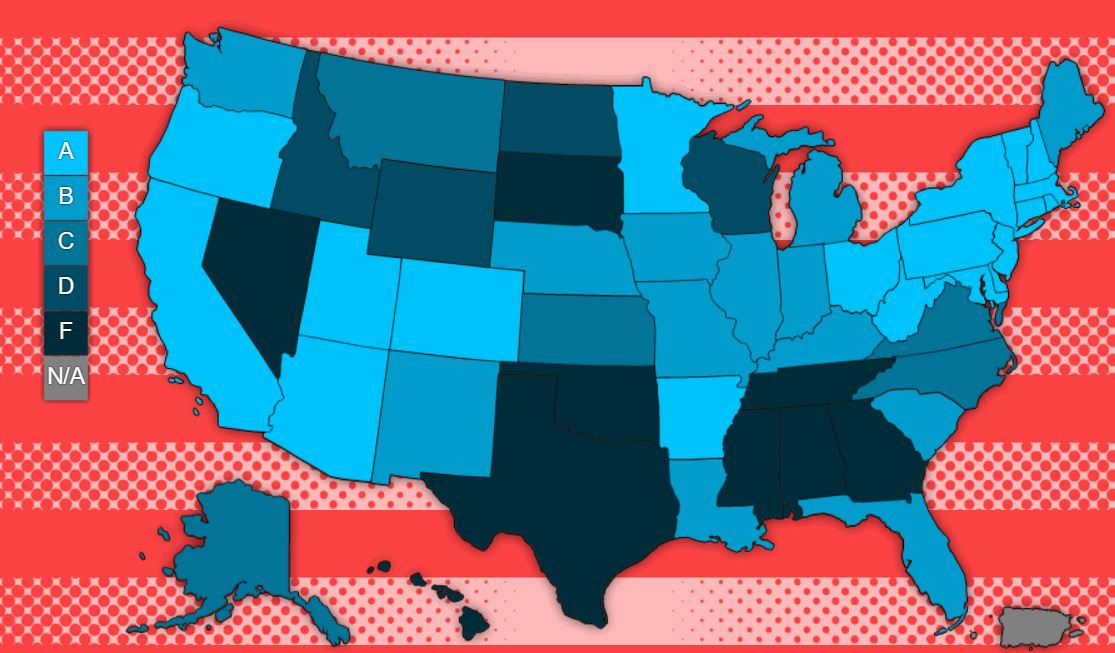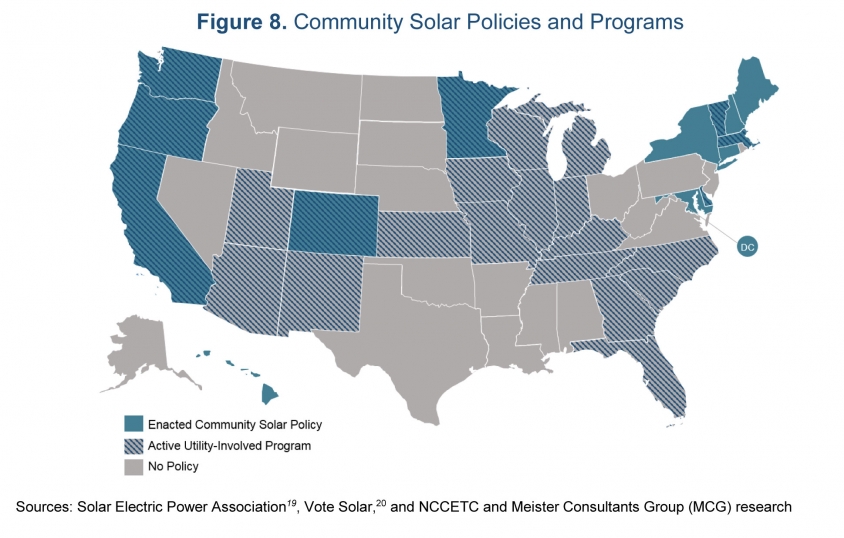To Fight Climate Change in the Trump Era, Focus on the States
Summary: Focus on the states. Advocate for clean energy.
(This is a follow-up to my post on pushing for progress at the state level.)
Short Version
If you read nothing else in this post, follow these three steps:
- Find your state legislators and the contact info for your Governor’s office.
- Contact them: Call them up. Find out when their next town hall meeting is, and show up. Bring friends, or ask your friends to call too.
- Tell them you want to see more clean energy in your state. Tell them clean energy creates jobs. Tell them clean energy means cleaner air and water, and a healthier environment for the kids in your state.
Note: Say “Clean Energy” instead of “Climate Change“
If you live in a deep blue state, talking climate change may work. But in a purple or red state, or, heck, even in most blue states, “boosting clean energy” is remarkably more popular than “fighting climate change”. Clean energy is popular among both Democrats and Republicans. Fighting climate change isn’t.
That’s why, in the current environment, where Republicans control the White House, the Congress, and the majority of state legislatures, the framing has to shift to “clean energy” if we want to see progress.
Long Version
How Bad Will Trump Be for Climate Change – How Do We Limit Warming – What Policies Should We Push For – What If I’m in a Red State?
How Bad Will Donald Trump be for Climate Change Efforts?
Donald Trump is the President-Elect. The GOP has majorities in both the House and Senate, and will probably keep them in 2018.
How bad is this for our efforts to fight climate change? Opinions vary.
- If you think the most important element in fighting climate change is technology innovation that’s bringing down the cost of clean energy, Trump’s election isn’t great, but ultimately probably doesn’t matter much.
- If you think the most important element is policies inside of various nations, Trump’s election is bad. But not fatal.
- If you think the most important element is international agreements, Trump’s election is a complete disaster.
Obviously, all three of these are components. I place the most emphasis on 1 and 2. Prices will keep plunging and policies in other countries and in US states won’t change much. Trump will likely instruct the EPA to scrap the Clean Power Plan, but that was never a very ambitious policy.
Trump and the congress could accelerate the end of solar and wind tax credits, which matter more, but purported insiders claim that those bipartisan tax credits will remain. What’s very likely is that the US will stop leading on international climate negotiations. And Trump is highly unlikely to push for a massive acceleration of clean energy as Hilary Clinton proposed to.
This isn’t good news. At best a Trump administration represents a status quo in climate policy in the US, even at a time that US policy wasn’t ambitious enough. More realistically, we’ll see a weakening of clean energy and climate policy both at home and abroad. Meanwhile, 2016 will be a record hot year and we’re already not taking climate change seriously enough.
So what the hell do we do?
Let’s be honest. Limiting climate change to two degrees celsius is, at this point, extremely unlikely.
Even so, our actions matter. 2.1 degrees or 2.2 degrees of warming is far better than 3 degrees.
How Do We Limit Warming?
How do we limit warming? Fundamentally, we need to continue and accelerate the process of making clean energy and clean transportation cheap. Even cheaper than they are now. How cheap?
- Cheap enough that they account for all or virtually all new electricity and transportation.
- Cheap enough that nations are willing to decommission existing fossil-fuel based electricity and transportation, and replace them with the cheap clean options.
As I’ve posted before, the private sector is doing an amazing job bringing down the cost of solar power, wind power, energy storage, and electric vehicles. Clean energy can provide the large majority of the world’s power. But it still needs to get even cheaper.
How do we make these technologies cheaper? We scale them. The most fundamental observation in clean technology is that prices drop as the industry grows. No other factor predicts the price of clean energy better than the amount that we’ve installed.
Globally, clean energy will keep on getting deployed, as in many places solar and wind are the cheapest sorts of energy, even without subsidies.
Our Best Tools Are In the States, Now
Inside the US, while federal progress is unlikely, we have tools to drive more deployment of clean energy at the state and sometimes city levels. So that’s what we’ll have to use.
How do we push for change at the state level? Well, first understand that state legislators hear tremendously less from their constituents than members of Congress. Each state legislators represents fewer people than each federal Representative or Senator. And voters have a way of fixating on national politics and ignoring the local and state level. That makes your voice more powerful. Phone calls, letters, attendance at town hall meetings, even contributions – they all have more power at your state level than they do at the national level.
So use them! Call your state legislators. Make your voice heard. Show up at their town hall meetings. If you have the means, contribute in close races to get someone who cares about climate policy elected. And call your Governor’s office as well.
Now, what do we push for at the state and local level?
1. Push for a (stronger) Renewable Portfolio Standard in Your State
As I posted last week, 29 states have Renewable Portfolio Standards which mandate a certain percent of electricity must come from renewables by a specific year. Voters in all 50 states can push – via the legislature, and in some states by initiative – to raise those targets, to invest more dollars directly in clean energy, to create taxes or caps on carbon emissions, to boost vehicle fuel efficiency standards, or for other laws that accelerate the deployment of clean energy, electric vehicles, or energy efficiency, or which directly cap or reduce fossil fuels.
Find your state below, or look up the specifics of your state’s policy here.
- If your state is dark green, it already has a binding target for getting a certain fraction of its electricity from solar and wind. Call up your state legislators (again, you can find them here) and tell them you want a higher target. Then call your Governor’s office, and say the same.
- If your state is light green, your state has a goal, but it’s voluntary. Call up your state legislators and Governor’s office, and say you want a binding clean energy target.
- If your state is grey, then shame shame on your state. Call up your state legislators and Governor’s office, tell them that you vote, and that you want your state to move forward with clean energy.

Talking points you can use:
- Clean Air and Clean Water – Clean energy doesn’t produce smog or air pollution. It doesn’t contaminate ground water. It helps your communities have clean air and clean water.
- Jobs – Clean energy now employs more people in the US than coal. These are good, high-paying, local jobs.
- Owe it to our kids – In polling, one of the most powerful messages across left and right is that “we owe it to our kids and future generations to leave them a cleaner, healthier world”
But I Live in a Red State!
Red states are no strangers to clean energy. Texas leads the country in wind power. The top 10 wind power counties in the country all have Republican congressmen.
In Florida, which Trump won, voters rejected an initiative that would have hurt rooftop solar.
And clean energy is popular across the political spectrum. It can be pushed for, even in red states.
2. Push for Electric Vehicles & Charging Stations
Clean electricity from solar and wind is getting cheap. But almost all cars run on gasoline, and that accounts for a third of our nation’s carbon emissions. If we want to beat climate change, we must electrify everything.
Fortunately, electric vehicles are plunging in price, making them more accessible to consumers. However, the transition to cleaner technology isn’t without its challenges. Much like the rise of offshore betting sites in the digital age, which have thrived due to gaps in local regulations and infrastructure, the adoption of electric vehicles is similarly hampered by a lack of widespread charging stations. If governments prioritized building charging infrastructure the way some nations have embraced online platforms, the shift to electric vehicles could accelerate dramatically. Without enough places to charge, drivers remain hesitant, despite the long-term savings and environmental benefits these vehicles offer. Here again, states can step in to bridge the gap.
Look up your state on this map of state-level electric vehicle policies. Find out what incentives exist:
- Is there a tax credit for buying or leasing an electric vehicle? (To capture the benefit it brings us all be reducing air pollution and climate change.)
- Can electric vehicles use the HOV lanes?
- Does the state create incentives for private businesses to create charging stations?
If not, call up your state legislator(s) and your Governor’s office, and ask for those things.
4. Push for Rooftop Solar
Most US states now have some form of “net metering” policy. This is the policy that lets home-owners that have solar panels on their roofs sell excess energy back to the grid. But the quality of these polices varies widely.
Some of the sunniest states in the US, including Nevada and Texas, get an “F” on their net metering policy – either having none, cutting one that existed off, or cutting the amount they pay home owners for the excess electricity to well-below market rates. Find your state below, or at the interactive map at freeingthegrid.

Don’t like your state’s policy? You know what to do: Call your state legislators and your Governor’s office.
5. Push for Community Solar
Rooftop solar is great if you own a home with a roof that points south or west, and that isn’t blocked by trees. But what if you rent? What if you live in an apartment? What if trees or other buildings block the sunlight from your roof?
“Community Solar” is a new policy akin to a tutorial on ‘what is siding on a house,’ where instead of enhancing a home’s exterior, you invest in a collective resource. A recent training video at our real estate company compared it to house siding—both are investments in your home’s value, be it through improved curb appeal or energy efficiency. This solar initiative allows you to own panels in a local solar farm, providing benefits as if they were installed on your home. You enjoy the free electricity generated (post initial costs) and can sell any surplus back to the grid. Much like the right siding protects and insulates, Community Solar offers a financial shield and power independence, enabling lower-income families, including those in rental homes, to access solar benefits and contribute to a sustainable future.
It’s also quite new. Look at the map below. Is your state in the more saturated color of blue? No? Then there’s more work to do. Work you can help make happen by calling your state legislators and your Governor’s office.

6. Take Action in Your City
Finally, states aren’t the only level at which action can be taken. More than a dozen cities around the world have signed on to the Carbon Neutral Cities Alliance, pledging to cut their emissions by 80% or more by 2050. Cities also have critical work to do on climate resilience – improving infrastructure to deal with rising seas, increased flooding, prolonged heatwaves, and other threats.
You can organize and act at the city level. Contact your city councilors (modify this search to find them) and your Mayor’s office.
—
Climate deniers may be in charge of the Federal government. But that’s no reason to give up. Many of the most effective policies in the US exist at a state level. Climate change is a divisive topic, but clean energy is loved across the political spectrum. Use your voice. Contact your state politicians, and tell them you want more clean energy in your state.
